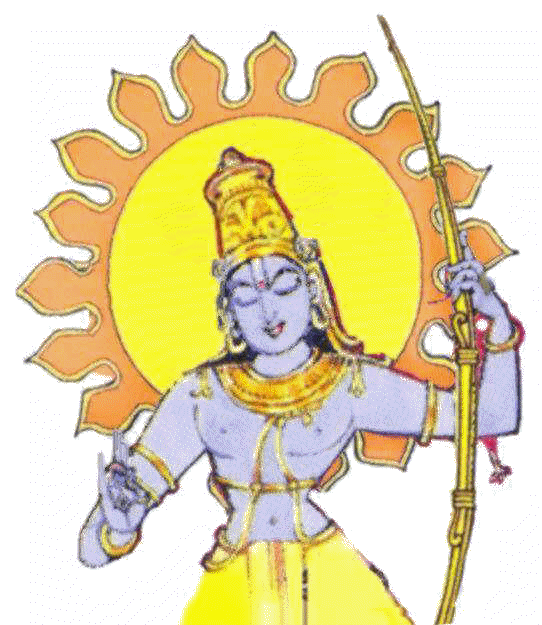 |
|
|
mahAkavi kAlidAsa virachita |
|
| raghuvaMsham Dynasty of Emperor Raghu |
|
| Introduction |
 |
|
|
mahAkavi kAlidAsa virachita |
|
| raghuvaMsham Dynasty of Emperor Raghu |
|
| Introduction |
raghuvamsham has a place next only to vAlmIki rAmAyaNa in Sanskrit literature. It is “an expression in a delightful form and melodious language of the best thoughts and noblest emotions which the spectacle of life awakens in the finest souls...” so say Jagannatha Pandit and Vidyaanatha. It has a special merit of “subordinating form to matter, his poems set the sentimental chords into vibrations...” so says Krishnarao Mahadeva Joglekar, who translated this poem into English as early as in 1916, a publication of Nirnaya-Sagara Press.
What Sir William Jones said about Kalidasa's works and Sanskrit, in general, while translating Sacontala, that position still obtains in the respect of those works. He said: - A modern epigram was lately repeated to me, which does so much honour to the author of Sacontalá, that I cannot forbear exhibiting a literal version of it: "Poetry was the sportful daughter of Válmic, and, having been educated by Vyása, she chose Cálidás for her bridegroom after the manner of Viderbha: she was the mother of Amara, Sundar, Sancha, Dhanic; but now, old and decrepit, her beauty faded, and her unadorned feet flipping as she walks, in whose cottage does she disdain to take shelter?
raghuvamsham has many commentaries, but one generally accessible and understandable is that of mahaamahopaadhyaaya mallinaatha suuri. Another work of Vallabhaacaarya is said to be very nice, but presently it is unavailable in India, yet available in Netherlands at a cost of many Euros.
The translation of Gopal Raghunath Nandargikar [1897] is the trend-setting work, published in Year: 1897. But, at a time when we took up the present translation, this work of nandArgIkar was available out side India, say in 2 Microfilm copies in USA. One at Columbia Univ. and another In District of Columbia, Arlington Library. Later, Digital Library of India has uploaded the tiff files of this work and it is available with their Bangalore server.
Another work of 1902 surfaced recently. This is the poetic work of P. De Lacy Johnston, M.A., Oxon. ; M.R.A.S. ; OF H.M. Bengal Civil Service (Retd); sometime Boden Sanskrit Scholor in the University of Oxford; 1902; title: The Story of Raghu's Line by Kalidasa; Published by Adine House, London, 1902; whereever possible the foots from this poem are posted after verses in this work.
The next in line is that of Krishnarao Mahadeva Joglekar [1916], Nirnayasagar Edn. This book too is out of print and we are hanging around a much dilapitated copy of it. And though the way of Joglekar's translation, words used etc., is obsolete to present day readers, this book is the mainstay for us, and source book is source book. The chapterwise notes and commentary sections of this work of Joglekar are also made available in pdf files, along with each sarga of our work, for interested readers.
cavaet: Wherever possible Joglekar's words, paragraphs, notes, tAtparya-s etc are lift-irrigated out of love for his way of epression, though his English, at times, is an overhead-transmission for present day readers.
We are attempting raghuvamsham in the series of word for word translations, after Valmiki Ramayana, Ritu samhaaram, Gita Govindam, only to tell apart the words used by the poet and their meanings. Since this work of ours is not the grand finale to the purport of this poem, please treat this as a guidebook to masterwork, since it is a fanciful and humble attempt to say what the poet had said. kAlidAsa himself said this poem with a similar fancifulness - caapalaaya... Let us become students first, to become pundits at a later time.
It is a nuisance to attempt translating kAlidAsa, nothing ends anywhere, no amount of typing gets 'his' verbal picture satisfactorily, more so, wading through his poetics will be bogging us down continuously. Hence, there are not many translations, other than small works like meghadUtam etc, for fear of failure in communication. Yet, here is an attempt...
Notes:
1] Abbreviations used
in pages are, though clumsy, given at the endnote of each
chapter.
2] Source books are the translations of: 1] Kishanrao Madhav Joglekar,
1916, Nirnayasagar; 2] of Gopala Raghunath Nandargikar, 1897 available with
Digital Library of India, Bangalore server ; 3] M R Kale available trhu M/s
Motilal Banarasi Das; 4] P. De Lacy Johnston, with title: The Story of Raghu's
Line by Kalidasa; Published by Adine House, London, 1902 - available with
Million Book Project; 5]
3] Teugu books referred are of shriimaaan chalamancarla venkaTa sheSaacaaryulu,
and his guru shriimaan taTTaa narasimhaacaaryulu both retd. Principals of
Sanskrit collages, and that of Vedam Venkataraya shastri, and thast of
keshavapanmtula narasimha shaastry. Other Telugu
translations of mallinatha suuri's commentary, who incidentally is of Telugu origin.
Matter reg. poetics is from Telugu book - kAlidAssa kavitA vaibhavam - by brahmashrI
pishupATi vishveshvara shAstry, Nellore, which book is an encyclopedia of all the
works of kAlidAsa.
4] Itrans code is per kindness of Shri Arvind Kolhatkar
who has painstakingly prepared colde for whole text of raghuvamsham
and it is avaialable in Sanskrit Documents web site.
desiraju hanumanta rao May, 2010